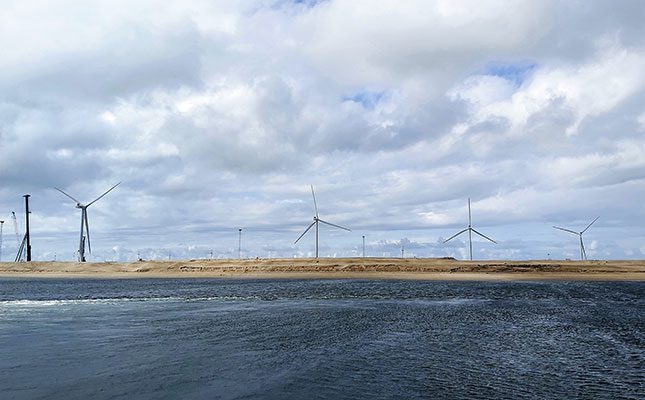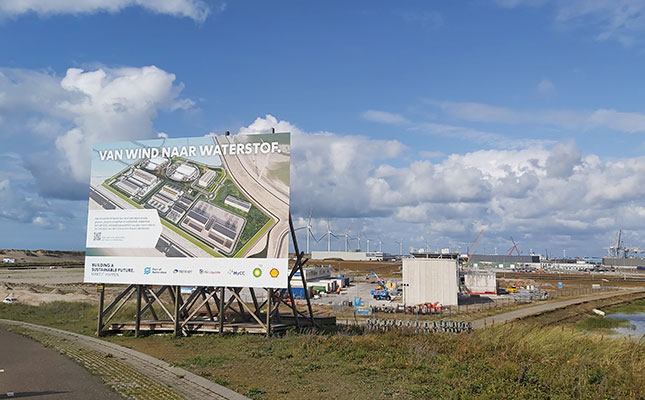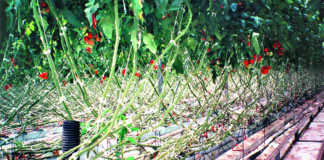
Photo: Lindi Botha
The Netherlands’ coastline is a cool and windy place on the best of days. It’s hardly the kind of beach destination South Africans are used to, but it does have monumental benefits: wind power generation.
The Dutch have certainly capitalised on this gift from nature, and wind turbines span across the ocean as far as the eye can see. But it’s not enough.
READ Wind farms: a massive opportunity for SA’s farmers
Shortly after the Russians declared war on Ukraine, the EU shunned Russian gas. The urgency to reduce carbon emissions has also driven the continent to seek more green energy, with the Netherlands shutting down their own gas fields last year.
Erecting enough wind turbines across the North Sea to meet their green energy requirements, and transforming the mostly gas-suited energy infrastructure, could take up to 10 years to establish, and come at a considerable cost.
Green hydrogen poses an ideal solution, but only if they can procure enough of it. Green hydrogen is produced by using renewable electricity in an electrolyser to split water into hydrogen and oxygen.
The Dutch’s attention has therefore shifted south, where sunshine is abundant, and South Africa’s west coast presents an ideal location for using desalinated water and solar energy to produce hydrogen, which can then be exported through purpose-built ports.
Should investment in green hydrogen production in South Africa materialise, and the country does indeed become the hydrogen powerhouse it is realising it could be, benefits to African and European economies will be plentiful.
President Cyril Ramaphosa recently stated that the hydrogen economy has the potential to add 3,6% to South Africa’s GDP by 2050, and around 370 000 jobs.
Should South Africa use green hydrogen in its own energy mix, Ramaphosa estimates that it would remove 10% to 15% of our domestic emissions and contribute to the country’s long-term energy security.
Benefits for South Africans and the Dutch aside, it is estimated that green hydrogen would need to make up 10% to 20% of the global energy mix to limit global warming to less than 1,5°C. With demand this high, South Africa will need to prioritise hydrogen production to scoop up the enormous benefits.
Abundant opportunities
The Minister in the Presidency for Electricity, Dr Kgosientsho Ramokgopa, stated that existing infrastructure like ports and renewable energy sources can be leveraged for green hydrogen production.
READ Energy storage can enhance SA agriculture
“The Western Cape plans to develop Saldanha Bay into a green hydrogen production centre, with the Atlantis Special Economic Zone as a key hub for green hydrogen value-chain components.
The Northern Cape has finalised its Green Hydrogen Roadmap, with potential investments ranging from R5,7 trillion to R9,5 trillion by 2050. The Eastern Cape plans to implement its strategy primarily in the Coega Special Economic Zone.
Green hydrogen can contribute significantly to the national revenue funds of many African countries. Ramokgopa put the figure at R380 billion annually.

“It’s revenue that can be used to expand social infrastructure, improve the quality of life of our people and ensure that we put Africa on a pedestal for significant growth going into the future.”
The estimated cost to produce hydrogen in South Africa, coupled with closer proximity to Europe than countries like Chile and Australia, makes it more cost effective for the Dutch to import this energy from South Africa.
Ramokgopa said Sub-Saharan Africa’s renewable energy resources have the capacity to produce between 5 000 and 13 000 million tons of green hydrogen per year, at a cost of around R38/kg, by 2050. This would make green hydrogen financially competitive against other energy sources.
Not so fast
But getting to the R38/kg price point will take time and considerable investment in new, leaner technologies. For now, the price is expected to be around double that, which could dampen global appetites for South African hydrogen.
Ramokgopa said the cost of green hydrogen for the end user would be so prohibitive for South Africans that it had not been included in the updated Integrated Resources Plan.
The road to mass hydrogen production is eye-wateringly expensive as it requires an entirely new industry to be built.
This includes all the infrastructure that goes with it: new ports that can handle gas exports, solar and wind farms that are connected to a grid that can receive power, rather than provide, pipelines and railways to transport gas across the country, desalination plants, and the hydrogen plants themselves.
South Africa has plans to launch the SA-H2 Fund, a blended finance fund that will facilitate the development of the hydrogen sector.
The aim is to attract R19 billion in funding. With Africa being favourably looked upon for assistance with Europe’s green transition, financing has become readily available.
But Jörg Gigler, director of TKI New Gas in the Netherlands, raised a red flag for anyone wanting to profit from hydrogen projects and the money changing hands.
“Provisions for green financing take the stability of the country, and the global transparency and corruption rankings into account. There are countries in South America that would make excellent candidates for hydrogen production, but corruption is so rife that the banks refuse to finance them, so they can’t get their projects off the ground,” Gigler said.
He cautioned the South African government and private officials against corruption if they were to attain the financing they needed to make the hydrogen dream a reality.
While government has released information on hydrogen production targets, there have been no implementation plans to date.
In late October this year, Cabinet approved the Green Hydrogen Commercialisation Strategy for implementation, with the goal of positioning South Africa as a major producer and exporter of green hydrogen.
This falls under the Department of Science and Innovation’s Hydrogen Society Roadmap, which has set a target of having 10GW of electrolysis deployed and at least 500 000t of hydrogen production per year by 2030.
By 2040, capacity should be expanded to reach 15GW. On the demand side, the short-term focus is on the transport sector and demonstrating industrial technologies. The long-term roadmap envisions sector coupling and use of hydrogen in the power sector.
Private sector investments have also been slow, with Sasol being the only company in South Africa that has a hydrogen production facility up and running.
The facility, in Sasolburg is however only at the pilot stage, producing 150kg of green hydrogen per day since the plant started running in June this year.
They have set a target of reaching 5 500kg per day in 2024. Sasol however expects that it will take at least a decade for green hydrogen to become a fuel of choice for the company, as cost, infrastructure and regulations pose hurdles.
Going halfway around the world to procure green energy but then creating carbon emissions during the transport proses would be pointless. The hydrogen sector is therefore just as busy developing ways in which hydrogen can be shipped, in ships run on hydrogen-derived fuel.
Gigler noted that 90% of the Netherlands’ hydrogen requirement will need to be imported. With deep sea transport contributing to 3% of global emissions, dirty transport will need to be addressed.
While hydrogen is relatively light, it does take up a lot of space, and Gigler stated that ships carrying 100 times the cargo they currently can, needed to be constructed to make transport safe, efficient and affordable.
Iridium: vital but scarce ingredient
South African challenges aside, there is one detail that plagues global hydrogen production, which could very well stifle any hopes of fully utilising this green energy.
Iridium is a vital ingredient in the electrolysis process that turns water and electricity into hydrogen. But the world is running out of this scarce metal.
Peter Paul van ’t Veen, business development director of innovation for development at research organisation TNO in the Netherlands, says that South Africa currently supplies 90% of all the iridium used in the EU.
South Africa is, in fact, the largest producer of iridium in the world, which bodes well for developing our hydrogen sector. But since demand for iridium is already high, prices will continue to rise as hydrogen production increases globally, making the cost of producing this energy more expensive.
Unless iridium can be entirely replaced by another technology or ingredient that is more abundant, hydrogen production could be stopped in its tracks before we even reach 2050.
Income for farmers
Talk about expanding solar production in South Africa is bound to grab the attention of farmers in the Northern and Western Cape. With rain being scarce, and fires common, earning a living from this dry land is challenging.
The abundant sunshine could however be the golden goose that will allow farmers to farm simply for the enjoyment thereof.
Willem Symington, president of Agri Northern Cape, said the region’s farmers were excited by the economic injection the hydrogen sector would bring the province.
“Farmers could erect their own solar plants and sell the electricity, or they could rent the land to solar power companies who need to erect more solar farms. In certain areas, wind turbines are also feasible.
“With so many droughts, and with the climate set to get drier, it will be a huge benefit for farmers to have an alternative source of income.”
Possible benefits stretch beyond rental income, and the development of rail networks and ports that would come with a thriving hydrogen industry will have benefits for farmers too.
“If the port development in Boegoebaai goes ahead, it would be far closer for the Northern Cape’s export-focused farmers to send their fruit there rather than to Cape Town. If railway lines were developed, we could see the mines shifting their cargo off the roads, which would ease the detrimental impact that the trucks have on our road infrastructure, Symington said.
A big caveat to the development of a hydrogen industry would be the assurance that the region’s fresh water sources would not be touched.
“It is said that seawater will be desalinated and used in the hydrogen production process, but it is expensive and could make the cost prohibitive. Every drop of water flowing down the Orange River has already been accounted for, so using it is not an option.”
Email Jörg Gigler at [email protected], or Willem Symington at [email protected]











